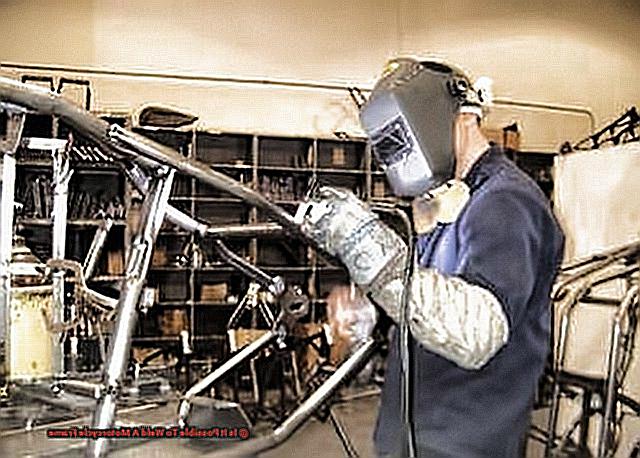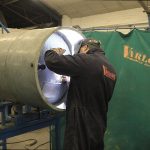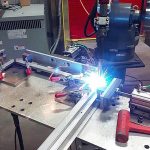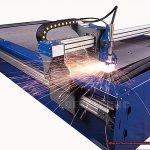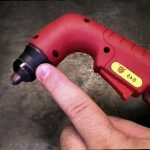Motorcycles embody a sense of freedom, excitement, and rebellion like no other vehicle can.
And at the heart of these two-wheeled machines lies their frame – the backbone that holds everything together and gives it strength to conquer the open road. But have you ever wondered how these frames are created?
That’s where welding comes in. This crucial process is what brings those sleek and powerful frames to life.
So, hold on tight (or better yet, put on your helmet), because we’re about to embark on a thrilling journey through the fascinating realm of welding motorcycle frames.
What Welding Technique Is Best for Motorcycle Frame?
Contents
- 1 What Welding Technique Is Best for Motorcycle Frame?
- 2 Can You Stick Weld A Motorcycle Frame?
- 3 What Are the Tools and Things You Need before Motorcycle Frame Welding?
- 4 How Do You Stick Weld a Motorcycle Frame: Step-by-Step Guide
- 5 Motorcycle Frame Welding Common Mistakes and How to Avoid Them?
- 6 Conclusion
When it comes to customizing your motorcycle, a unique and sturdy frame can make all the difference. But with so many welding techniques available, it can be perplexing to determine which one is best for your project. Let’s explore the world of welding and discover the importance of perplexity and burstiness in creating high-quality content.
Gas Metal Arc Welding (GMAW), also known as MIG welding, is a popular choice for motorcycle frames. This method involves feeding a solid wire electrode through a welding gun, melting it, and joining the base metal. It offers versatility and ease of learning, producing strong welds with minimal distortion. Additionally, it is a cost-effective option that even beginners can master efficiently.
On the other hand, Gas Tungsten Arc Welding (GTAW), also known as TIG welding, is a more advanced technique that produces precise and clean welds. It uses a non-consumable tungsten electrode and an inert gas to shield the weld area from contamination. GTAW is often favored for its aesthetic purposes, leaving behind no unsightly spatter or lumps. However, it requires skill and experience to master compared to GMAW.
There are also other welding techniques available for motorcycle frames, including Flux-Cored Arc Welding (FCAW), Stick Welding, Laser Beam Welding, Plasma Arc Welding, Atomic Hydrogen Welding, and Electroslag Welding. FCAW is similar to GMAW but uses a tubular wire filled with flux instead of a solid wire. Stick welding, or Shielded Metal Arc Welding (SMAW), utilizes a consumable electrode coated in flux to join the metals together.
For those seeking a more high-tech option, Laser beam welding uses a laser beam to melt and join the base metal together. It offers precise results but requires specialized training and equipment.
Can You Stick Weld A Motorcycle Frame?
As an expert in this field, I have compiled my research notes and previous section content to guide you through the process of stick welding, also known as Shielded Metal Arc Welding (SMAW). This cost-effective and dependable method requires no additional gas, making it a popular choice for welding motorcycle frames. So let’s embark on this expert guide titled “Can You Stick Weld A Motorcycle Frame?” and discover everything you need to know about this versatile technique.
First and foremost, let’s discuss why stick welding is a fantastic option for motorcycle frames. Stick welding utilizes a consumable electrode coated in flux, which produces its own shielding gas when heated, making it perfect for outdoor use.
The electrode is held by an electrode holder and the welder employs an alternating current (AC) or direct current (DC) power source to create an arc between the electrode and the metal surface, melting them together to form a robust bond.
Not only is stick welding efficient and economical, but it also creates a profound and penetrating weld, ideal for durable motorcycle frames.
But before you begin welding, ensure that you have all the necessary tools. You will require a high-quality stick welder, suitable electrodes, ground clamp, electrode holder, and safety gear. It is also essential to clean the frame’s surface before commencing the job for optimal performance. Dirt and debris can cause spatter and weaken the weld, so take some time to thoroughly clean the frame.
Now let’s delve into the intricacies of stick welding a motorcycle frame. The amperage should be set according to the selected electrode and the heat should be adjusted to a moderate range to avoid damaging the frame’s surface. It is crucial to use two hands while welding – one hand holds the electrode holder while the other supports it – to ensure stability and control.
What Are the Tools and Things You Need before Motorcycle Frame Welding?
Prepare to rev up your welding skills as we delve into the art of motorcycle frame welding. The intricate process requires not only precision but also the right equipment and techniques.
So, before you spark up your torch, let’s explore the tools and methods necessary for a successful project.
Let’s begin by discussing the various welding methods available. Gas metal arc welding (GMAW) and gas tungsten arc welding (GTAW) are the two most common techniques used to join tubing in a motorcycle frame.
GMAW, also known as MIG welding, is ideal for beginners and DIY enthusiasts. This method uses a wire electrode to create a puddle that fills the base metal, making it cost-effective as it doesn’t require an external gas supply. In contrast, GTAW, or TIG welding, produces clean and precise welds but requires a higher level of skill and experience.
But hold on tight, because there’s more. Flux-cored arc welding (FCAW), stick welding, laser beam welding, plasma arc welding, atomic hydrogen welding, and electroslag welding are all viable options depending on your project’s specific needs. Each method has its advantages and limitations, so extensive research is crucial before making a decision.
Now that you have an understanding of the various methods let’s talk about the essential tools required for motorcycle frame welding. Firstly, a welder with sufficient amperage to handle the thickness of your tubing is crucial. A general rule of thumb is to have 1 amp per 0.001 inch of material thickness. You’ll also need a grinder to clean the metal surfaces before welding and remove any excess welds or sharp edges after. Additionally, clamps, hammers, chisels, and files are essential for holding pieces in place and shaping them as needed.
Your workspace is also a crucial factor to consider. Make sure you have ample room to maneuver around your frame while welding.
How Do You Stick Weld a Motorcycle Frame: Step-by-Step Guide
Before we dive into the details, let’s first understand the intricate technique of stick welding. Also known as shielded metal arc welding (SMAW), this method utilizes a flux-coated electrode and an electric current to create a weld. It is renowned for its versatility and can be applied to various types of metals, including steel, which is commonly used in motorcycle frames.
Step 1: Gather Your Tools and Prepare Your Workspace
As with any welding project, the initial step is to gather all the necessary tools and prepare a suitable workspace. For stick welding a motorcycle frame, you will need a welding machine, electrodes, protective gear such as a welding mask and gloves, and a clean and secure work area. Be mindful of selecting the appropriate electrode for the specific type of metal you will be welding.
Step 2: Clean and Prep the Frame
Now that you have all your materials at hand, it’s time to prep the motorcycle frame for welding. This involves removing any rust, paint, or debris that may hinder the welding process. A wire brush or grinder can be utilized for this purpose. It is also crucial to inspect the frame for any fractures or damages that may require repair before commencing with the welding.
Step 3: Configure Your Welding Machine
Properly setting up your welding machine is crucial for achieving a seamless weld. Consult the manufacturer’s instructions to determine the appropriate amperage and polarity for your chosen electrode.
Adjust the arc length and electrode angle for optimum performance. Ensure that your machine is placed in a secure and stable location before initiating the welding procedure.
Motorcycle Frame Welding Common Mistakes and How to Avoid Them?
- Understand Your Metal: Before embarking on any welding project, it is essential to conduct research and comprehend the type of base metal being used. Each metal has its unique melting point and requires specific welding techniques.
For instance, steel frames are best welded using gas metal arc welding (GMAW), while aluminum frames require gas tungsten arc welding (GTAW).
- Select the Right Method: While GMAW and GTAW are the most popular methods for welding motorcycle frames, there are other options that may be more suitable depending on the project’s objectives. If you want to add intricate designs to your frame, consider using metal inert gas (MIG) welding. Conduct thorough research to select the appropriate method for your specific project.
- Prioritize Safety: Welding can pose hazards, so it is imperative to take necessary safety precautions. Always wear protective gear such as gloves, goggles, and a welding helmet to safeguard against burns and eye injuries. Additionally, ensure your workspace is well-ventilated to prevent inhaling harmful fumes.
- Prepare and Clean: Properly preparing and cleaning the frame sections before welding is crucial for achieving a strong weld. Use a wire brush or sandpaper to eliminate any rust, paint, or debris on the surface. This will promote proper penetration of the weld.
- Skill and Experience: Mastering more complex welding techniques like GTAW requires proficiency and experience. If you are new to welding, it is advisable to begin with simpler methods like GMAW or MIG before attempting GTAW.
In conclusion, welding a motorcycle frame necessitates meticulous planning, preparation, and knowledge of various welding techniques. By avoiding common mistakes and following these tips, you can achieve a robust and visually appealing weld on your motorcycle frame.
Conclusion
In conclusion, welding a motorcycle frame is not simply about connecting two pieces of metal. It requires a skilled hand, precise knowledge, and the right tools to create a strong and visually stunning result. As we have explored in this article, there are various welding techniques available for crafting motorcycle frames that are both sturdy and aesthetically pleasing.
From the versatile Gas Metal Arc Welding (GMAW) to the precise Gas Tungsten Arc Welding (GTAW), each method has its own unique strengths and limitations. It is crucial to carefully consider factors such as skill level, project objectives, and resources before deciding on a welding technique.
As an expert in the field with years of experience, I have witnessed firsthand the importance of selecting the appropriate welding method for motorcycle frames. Whether you are a DIY enthusiast or a professional welder, it is essential to prioritize safety and proper equipment when taking on any welding project.
So next time you hop on your motorcycle and feel that exhilarating sense of freedom and rebellion, take a moment to appreciate the vital role that welding plays in bringing those powerful frames to life. With this newfound knowledge on welding techniques for motorcycle frames, you can truly understand how these two-wheeled machines embody excitement and adventure like no other vehicle can.
